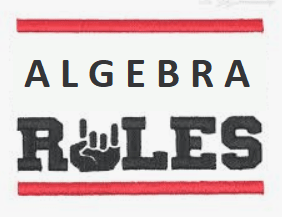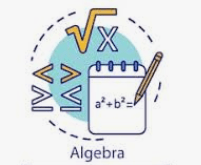Importance of Algebra's in Mathematics | Interesting Facts About Algebra

All About Algebra's
① History of Algebra
Origin of word "Algebra"
Coming from a Latin variant of Arabic word al-jabr
al-jabr meaning is "reunion of broken parts"
Who invented Algebra
Muhammad al-Khwarizmi has been described as the father of algebra or founder of algebra.
Muhammad ibn Musa al-Khwarizmi was a 9th-century mathematician and astronomer.
Definition of Algebra
Algebra is a branch of math that deals in representing numbers through variables.
Algebra also deals with symbols,relations,functions and equations.
Examples of Algebra
Algebraic expressions include at least one variable and at least one operation (addition, subtraction, multiplication, division).
For example, 2(x + 8y) is an algebraic expression.
② Rules of Algebra
Algebra Rule 1 (Distributive property of multiplication)
When a number is multiplied by the sum of two numbers, the first number can be distributed to both of those numbers and multiplied by each of them separately,
then adding the two products together for the same result as multiplying the first number by the sum.
a (b + c) = ab + ac
Example: 3(4 + 5) = 27 = 3 * 4 + 3 * 5
Algebra Rule 2 (Multiply a fraction with another value, multiply the numerator)
a*(b/c) = (a*b)/c
Any multiplication or division of the numerator of a fraction applies to the fraction as a whole, and vice versa.
Example: 6*(1/3) = 2 = (6*1)/3
Algebra Rule 3 (Dividing the numerator equals multiplying the denominator)
Divide the numerator by a particular number, it has the same effect on the fractions overall value as if you multiply the denominator by that same number
(a/c)/b = a/bc
Example: (1/5)/2 = 1/10 = 1/(2*5)
Algebra Rule 4 (Dividing the denominator equals multiplying the numerator)
Dividing the denominator of a fraction has the same effect as multiplying the numerator
a/(b/c) =ac/b
Example: 1/(6/2) = 1/3 = (1*2)/6
Algebra Rule 5 (Two fractions summed into one larger fraction)
Find a common denominator between two fractions by multiplying the numerator and denominator of each fraction by the other's denominator.
Example: 3/5 + 1/3 = (3*3)/(5*3) +(1*5)/(3*5) = 9/15 + 5/15 = 14/15
Algebra Rule 6 (Subtraction of two fractions into one fraction)
(a/b) - (c/d) = (ad - bc)/bd
Example: 3/5 - 1/3 = (3*3)/(5*3) - (1*5)/(3*5) = (3*3)-(1*5) / (3*5) = 9-5/15 = 4/15
Algebra Rule 7 (Reverse Subtraction)
Reversing a subtraction in both the numerator and the denominator of a fraction leaves the fractions value unchanged
(a-b)/(c-d) = (b-a)/(d-c)
Example: 3-5/2-1 = -2/1 = 5-3/1-2 = 2/-1 = -2
Algebra Rule 8
Split a fraction with an addition in the numerator into two fractions
two fractions with common denominators can be added by adding the numerators and leaving the denominator unchanged
(a+b)/c = a/c + b/c
Example: (1+2)/4 = 3/4 = 1/4 + 2/4
Algebra Rule 9 (Inverse of multiplication)
Factors in the numerator of a fraction that are the same as the denominator can be removed.
(ac+bc)/c = a+b
Example: (4*5)+(2*5)/5 = (4*5)/5 + (2*5)/5 = 4+2
Algebra Rule 10 (Two fractions into a fraction of two multiplications)
Convert a division between two fractions into a fraction of two multiplications
(a/c)/(b/d) = ad/bc
Example: (4/5)/(2/1) = 0.8/2 = 4/10 = 4*1/2*5
Algebra Rule 11 (Power)
The product of two powers with the same base is equal to that base raised to the sum of the two exponents.
am . an = am+n
Example: 33 = (3*3*3)(3*3) = 35
Algebra Rule 12
A number raised to a power raised to a power is equal to that number raised to the product of the two exponents
(an)m = anm
Example: (42)3 = (4*4)3 = (4*4)(4*4)(4*4) = 4*4*4*4*4*4 = 46 = 42*3
Algebra Rule 13 (Exponent)
Convert a multiplication with an exponent into the product of two factors each raised to the exponent
(ab)n = an bn
Example: (4*5)3 =(4*5)(4*5)(4*5) = 4*5*4*5*4*5 = 4*4*4*5*5*5 = 43*53
Algebra Rule 14 (Negative exponent)
The result of a negative exponent is the inverse of the same positive exponent
a-n = 1/an
Example: 2-2 = 1/22 = 1/4
Algebra Rule 15
A fraction raised to a negative exponent equals the inverse of the fraction raised to a positive exponent
(a/b)-n = (b/a)n
Example: (1/2)-2 = 1/(1/2)*(1/2) = 1/(1/4) = 4 = 22 = (2/1)2
Algebra Rule 16
A fraction with an exponent is equal to the same fraction with the exponent on the numerator and denominator
(a/b)n = an/bn
(3/4)2 = (3/4)(3/4) = 3*3/4*4 = 32/42
Algebra Rule 17
If the top and bottom of a fraction are both exponents with the same base, the fraction is equal to the base raised to the numerator exponent minus the denominator exponent.
an/am = an-m
Example: 44/42 = 4*4*4*4/4*4 = 256/16 = 16/1 = 42 = 44-2
Algebra Rule 18
Anything raised to the power of zero is equal to 1
a0 = 1
Example: 1230 = 1 = π = 1

③ Types of Algebraic Equations
An algebraic equation refers to an algebraic expression with a symbol of equality (=).
1) Linear Equations
A linear equation is an algebraic equation in which each term is either a constant or the product of a constant and a single variable.
The graph of linear equation is a straight line if there are two variables.
General form of the linear equation with two variables
y = mx + c, m ≠ 0
2) Radical Equations
An equation whose maximum exponent on the variable is 1/2 and have more than one term.
Example: √x + 10 = 26
3) Quadratic Equations
Quadratic equation is the second degree equation in one variable contains the variable with an exponent of 2.
General form of the Quadratic Equations
ax2 + bx + c = 0, a ≠ 0
4) Exponential Equations
An equation who have variables in the place of exponents. Exponential equation can be solved using the property: ax = ay => x = y.
Example: ab = 0 Here "a" is base and "b" is exponent.
5) Rational Equations
A rational equation is one that involves rational expressions.
Example: x/2 = (x+2)/4
④ Algebra Symbols
The following symbols and signs are used in Algebra.
Algebra math symbols Table
| Symbol | Symbol Name | Symbol Meaning |
|---|---|---|
| x | x variable | Unknown value to find |
| f (x) | Function of x | Maps values of x to f(x) |
| ≡ | Equivalence | Identical to |
| ≜ | Equal by definition | Equal by definition |
| := | Equal by definition | Equal by definition |
| ~ | Approximately equal | Weak approximation |
| ≈ | Approximately equal | Approximation |
| ≪ | Much less than | Much less than |
| ≫ | Much greater than | Much greater than |
| ( ) | Parentheses | Calculate expression inside first |
| [ ] | Brackets | Calculate expression inside first |
| { } | Braces | set |
| ⌊x⌋ | Floor brackets | Rounds number to lower integer |
| ⌈x⌉ | Ceiling brackets | Rounds number to upper integer |
| x! | Exclamation mark | Factorial |
| | x | | Single vertical bar | Absolute value |
| (f ∘g) | Function composition | (f∘g) (x) = f (g(x)) |
| (a,b) | Open interval | (a,b) = {x | a < x < b} |
| [a,b] | Closed interval | [a,b] = {x | a ≤ x ≤ b} |
| ∆ | Delta | change / difference |
| ∆ | Discriminant | Δ = b2 - 4ac |
| ∑ | Sigma | Summation - sum of all values in range of series |
| ∑∑ | Sigma | Double summation |
| ∏ | Capital pi | product - product of all values in range of series |
| ∝ | Proportional to | Proportional to |
| ∞ | Lemniscate | Infinity symbol |
Algebra Constants Table
| Symbol | Symbol Name | Symbol Meaning |
|---|---|---|
| e | Eulers number | e = 2.718281828... |
| γ | Euler-Mascheroni constant | γ = 0.5772156649... |
| φ | Golden ratio | Golden ratio constant |
| π | pi constant | π = 3.141592654.. |
⑤ Algebra Calculators
The following calculators are mostly used by students and teachers to resolve the algebraic expression.
⑥ Algebra Formulas
The following formulas are mostly used in Algebra problems.
(a+b)2 = a2 + 2ab + b2
a2 – b2 = (a – b)(a + b)
a2 + b2 = (a – b)2 + 2ab
(a – b)2 = a2 – 2ab + b2
(a + b + c)2 = a2 + b2 + c2 + 2ab + 2ac + 2bc
(a – b – c)2 = a2 + b2 + c2 – 2ab – 2ac + 2bc
(a + b)3 = a3 + 3a2b + 3ab2 + b3 ; (a + b)3 = a3 + b3 + 3ab(a + b)
(a – b)3 = a3 – 3a2b + 3ab2 – b3
a3 – b3 = (a – b)(a2 + ab + b2)
a3 + b3 = (a + b)(a2 – ab + b2)
(a + b)3 = a3 + 3a2b + 3ab2 + b3
(a – b)3 = a3 – 3a2b + 3ab2 – b3
(a + b)4 = a4 + 4a3b + 6a2b2 + 4ab3 + b4)
(a – b)4 = a4 – 4a3b + 6a2b2 – 4ab3 + b4)
a4 – b4 = (a – b)(a + b)(a2 + b2)
a5 – b5 = (a – b)(a4 + a3b + a2b2 + ab3 + b4)
If n is a natural number an – bn = (a – b)(an-1 + an-2b+…+ bn-2a + bn-1)
If n is even (n = 2k), an + bn = (a + b)(an-1 – an-2b +…+ bn-2a – bn-1)
If n is odd (n = 2k + 1), an + bn = (a + b)(an-1 – an-2b +…- bn-2a + bn-1)
(a + b + c + …)2 = a2 + b2 + c2 + … + 2(ab + ac + bc + ...)



